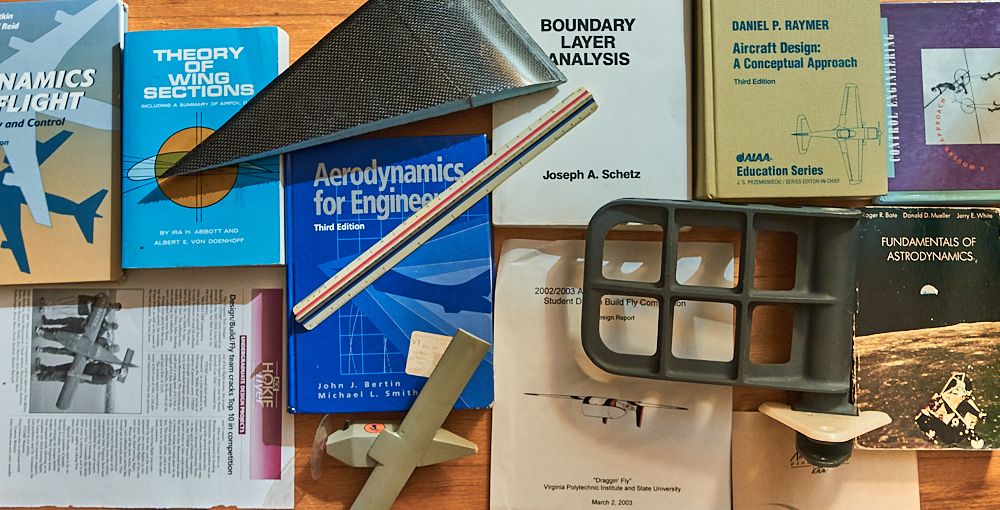We've already established the importance of People in what we'll be talking about here on Aero & Dynamics, and so it is worth a post to give all of you an idea of the person behind the blog, how I came to be passionate about elevating the discourse on this subject. Hopefully this will also shed some light on what Scott means when he says "Robertson Racing's Aerodynamicist is now writing posts". Covering this background might be especially important since I've leaned so heavily on the identity of "Sleepyhead the Buffalo" on the Grassroots Motorsports Forum, some Discord, and now here. Obviously, Buffalo are not People, and certainly are not aerodynamic... the role of their horns being vortex generators notwithstanding.
I should probably get the big splashy part of my background out the way first: I have a Bachelor's of Science in Aerospace Engineering from Virginia Tech's Aerospace and Ocean Engineering Department (VT AOE). In a later post, I'll dive into why that shouldn't matter... and I try not to let whether someone has a degree in Aerospace Engineering, or work in an Aerodynamics role in Motorsports, be a condition on whether they can/should be listened to about Motorsports Aerodynamics. Aerodynamicist, similar to "writer", is only loosely a job... and can be considered a hobby. In the realm of such ambiguity, providing educational background can be an important shortcut, in informing any of you reading that I've gone through the meat grinder of an engineering education in order to acquire the fundamental underpinnings of the dynamics that we'll be discussing here.
It's important to further explain that my having a degree in Aerospace Engineering alone, doesn't make me an "expert"... a term with which I'm entirely uncomfortable with. I battled through all 5 years of acquiring my degree, and very infrequently was able to sit in a class or read a textbook where the phrase was often thrown out of "it obviously follows that...", followed by some significant calculus simplification, transform, or other mathematical formulation. Invariably, for me, these things were never obvious; and my path to acquiring my degree was circuitous and not without failure. Some of this is due to my learning style not meshing well with the formal style provided in most engineering education.
My journey to understanding the fundamentals of fluid flows and aerospace engineering was significantly influenced by my participation in Virginia Tech's AIAA Design/Build/Fly team. This team has the rare distinction of having competed in every AIAA Design/Build/Fly competition (AIAA DBF). For those unfamiliar, the AIAA (similar to SAE) is the professional society for Aerospace Engineers (similar to IEEE is for Electrical Engineers, and SAE is for Automotive/Mechanical Engineers). "DBF" is a design contest for Aerospace Engineering students to design and build aircraft responding to new and unique design challenges every year (in comparison to Formula SAE, Baja, and SAE Heavy Lift), which include mandatory maneuvers to prove the built design can handle the types of maneuvers full-scale aircraft would normally encounter.
My experiences with DBF directly impacted my understanding and learning of aerospace engineering and design, informed my choice of capstone design project selection, and had a significant impact on my securing a Software Engineer position at a small full motion aircraft simulator company - working on "Control Loading Simulation" subsystems. Working that job exposed me to a lot of data collection, data analysis, human factors, controls & dynamics, and troubleshooting domains... not to mention simulation and model development.
While establishing my career in aircraft simulation, I realized that I had a window of opportunity to attempt a driving event I'd been a enthusiast of since stumbling across Dale Seeley's LakeEffectRacing blog. This was a web1.0 blog that cataloged his adventures at Brock Yates' One Lap of America, circa 1998. I took that chance: sold my NB miata, bought a Honda Fit to take to OneLap, and signed up for an HPDE at VIR. What was meant to be a "One and Done", has turned into an encompassing passion in Grassroots Motorsports. I've managed to do HPDE events sporadically since, and OneLap seven more times.
Through OneLap I've realized my identity as Sleepyhead the Buffalo (thanks in large part to Scott's Track Walking co-host, Seth Lemke). I've gained a host of new friends and experiences. It eventually led me to joining the Grassroots Motorsports Forum. Steve Stafford on GRM has been instrumental and kind in passing along his knowledge in some of the specific characteristics of Motorsport Aerodynamics, and background knowledge of JavaFoil. Being on GRM has also afforded me the chance to try my hand at helping in the analysis and development of more complex aerodynamic motorsport designs. My particular thanks goes to Dan ("nocones") who's LMP360 project has been a particular highlight.
Scott Robertson is, perhaps obviously, another significant figure that I've come to know through OneLap. Scott specifically, and GridLife in general, has afforded me a venue to apply dormant skills, and a person to talk with to refine both my teaching of the fundamentals of aero, and "philosophical" arguments about aero. We've managed to test and implement several unique modifications on the Robertson Racing Miata, some which have filtered into the GridLife paddock (fender vent bargeboard- sidesill). I've helped in the design of others that haven't made as much of an impact (the Scott named "Frankenwing", modified Ebay aluminum rear aero flap). Scott (and a few other GridLife entries) have graciously allowed me to expand my expertise with flow visualization... which has had a significant impact on our ability to evaluate and optimize "as implemented" performance of aerodynamic components compared to their published data. I've even been able to utilize my software troubleshooting skills, and model building and performance analysis background to help ascertain directions for future developments we have planned for the Miata (at a minimum).
Hidden in these experiences lies the conviction that the fundamentals of aerodynamics are important to being able to evaluate the current state of a motorsports design, and analyze the areas where optimization can be found. I hope to contribute to elevating the level of understanding of these fundamentals, and communicating them in ways that are accessible to drivers, racers, crew, dreamers, hobbyist, engineers, and everyone in between. In the pursuit of this, I will be arguing for new philosophical frameworks for conceptualizing/discussing motorsports aerodynamics, in the context of these fundamentals... so that some of the legacy terminology frequently used in motorsports has better context and coherence with the fundamentals.
Until the next time,
Tim "Sleepyhead the Buffalo" Miller
Standard Buffalo Post Scripts:
Gratias tibi ago:
I am not a lone Buffalo in this endeavor, so I'd like to express my appreciation to Scott Robertson and Beverly Miller in assisting in the publication of this post.
Caveat:
I am an Engineer, and a Buffalo. I do not have an English Degree. While an effort has been made to catch any any grammatical mistakes, there are bound to be some. Similarly, there's every chance I've screwed up some math somewhere. Hopefully you can look past any of the compositional/grammatical errors, to find value within. If there are mathematical errors, feel free to engage us constructively via social media, or one of the options available on our Contacts Page.

